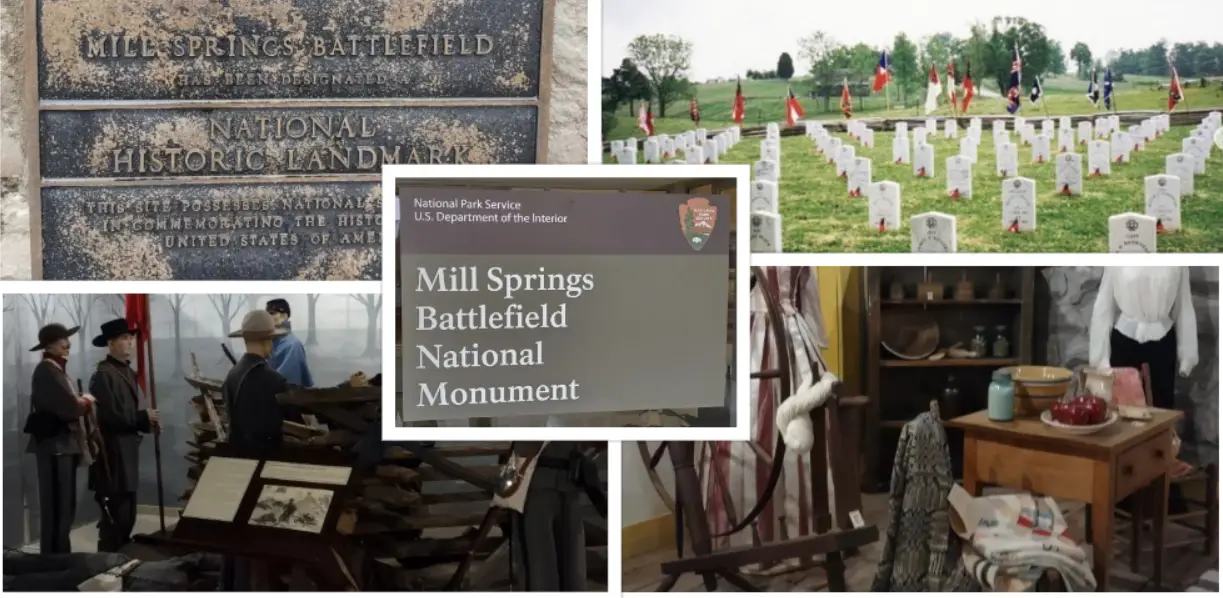Mill Springs Battlefield National Monument : Interesting Facts, History & Travel Guide

- By
- Aparna Patel
- |
- 12 Apr, 2023
- |

Mill Springs Battlefield National Monument is a historical site in Kentucky that commemorates the Battle of Mill Springs, which was fought during the American Civil War. This national monument is an essential piece of Kentucky’s history, and it offers visitors a unique opportunity to learn about the pivotal battle that helped secure control of the state for the Union.
In this article, we will take a closer look at the fascinating history of the Mill Springs Battlefield National Monument, explore some interesting facts about the site, and provide a travel guide to help you plan your visit. Whether you’re a history enthusiast or simply looking for a unique outdoor experience, Mill Springs Battlefield National Monument is a must-visit destination.
Interesting facts about Mill Springs Battlefield National Monument
- Mill Springs Battlefield National Monument is located in Nancy, Kentucky, and commemorates the Battle of Mill Springs, which was fought on January 19, 1862, during the American Civil War.
- The battle was a Union victory and was significant because it gave the Union control of much of Kentucky and paved the way for the Union Army’s advance into Tennessee.
- The national monument was established on December 16, 2019, and is one of the newest national monuments in the United States.
- The monument covers 916 acres and includes the battlefield itself, as well as several historic structures and sites, such as the Brown-Lanier House, which served as a hospital during the battle.
- Visitors to the monument can take a self-guided tour of the battlefield, which includes several interpretive signs and markers that provide information about the battle and the soldiers who fought there.
- The monument also features a visitors center with exhibits on the battle, as well as a gift shop and a theater that shows a short film about the battle.
- The monument is open year-round, although the visitors center has limited hours during the winter months.
- Mill Springs Battlefield National Monument is part of the National Park Service’s Civil War Discovery Trail, which includes more than 600 sites related to the Civil War across 32 states.
- The monument is also part of the Kentucky Civil War Heritage Trail, which includes 48 historic sites related to the Civil War in Kentucky.
- The Mill Springs Battlefield Foundation, a nonprofit organization dedicated to preserving and promoting the battlefield, played a key role in advocating for the monument’s establishment.
Information & History of Mill Springs Battlefield National Monument
Mill Springs Battlefield National Monument is a historical site in Kentucky that was established to commemorate the Battle of Mill Springs, which was fought on January 19, 1862, during the American Civil War. The battle was a key Union victory and helped to secure control of Kentucky for the Union forces.
During the Civil War, the Confederate Army sought to gain control of Kentucky and use it as a base for future military campaigns. In response, Union forces moved to secure the state and prevent it from falling into Confederate hands. The Battle of Mill Springs was one of the first major battles of the war in Kentucky, and it was fought between approximately 10,000 Union soldiers under the command of General George H. Thomas and around 6,000 Confederate soldiers under the command of General George B. Crittenden.
The battle took place in and around Mill Springs, Kentucky, along the Cumberland River. The Confederate forces initially had the advantage and pushed the Union forces back, but the Union troops regrouped and counterattacked, ultimately winning the battle. The victory was significant because it gave the Union control of much of Kentucky and paved the way for the Union Army’s advance into Tennessee.
After the war, the battlefield fell into private hands, and some parts of it were used for farming or other purposes. In the early 20th century, a movement began to preserve the battlefield and commemorate the soldiers who fought there. In 2001, the Mill Springs Battlefield Association, a nonprofit organization dedicated to preserving and promoting the battlefield, purchased a large portion of the battlefield and began working to establish it as a national monument.
In 2019, the Mill Springs Battlefield National Monument was established by an act of Congress, and it became one of the newest national monuments in the United States. The monument covers 916 acres and includes the battlefield itself, as well as several historic structures and sites, such as the Brown-Lanier House, which served as a hospital during the battle.
Read More:
- Medgar and Myrlie Evers Home : Interesting Facts, History & Travel Guide
- Marianas Trench Marine National Monument : Interesting Facts, History & Travel Guide
- Little Bighorn Battlefield National Monument : Interesting Facts, History & Travel Guide
- Lava Beds National Monument : Interesting Facts, History & Travel Guide
Today, visitors to the monument can take a self-guided tour of the battlefield, which includes several interpretive signs and markers that provide information about the battle and the soldiers who fought there.
The monument also features a visitors center with exhibits on the battle, as well as a gift shop and a theater that shows a short film about the battle. The Mill Springs Battlefield Foundation continues to play an active role in preserving and promoting the site.
More Articles
FAQ about Mill Springs Battlefield National Monument
What is the history of the Battle of Mill Springs?
The Battle of Mill Springs was fought on January 19, 1862, during the American Civil War. It was a key Union victory that helped secure control of Kentucky for the Union forces. The battle took place in and around Mill Springs, Kentucky, and was fought between approximately 10,000 Union soldiers and around 6,000 Confederate soldiers.
What is the significance of the Mill Springs Battlefield National Monument?
The Mill Springs Battlefield National Monument was established to commemorate the Battle of Mill Springs and to preserve and promote the site’s historical significance. The battle was one of the first major battles of the Civil War in Kentucky, and the Union victory helped secure control of the state and pave the way for the Union Army’s advance into Tennessee.
What can visitors expect to see at the Mill Springs Battlefield National Monument?
Visitors to the monument can take a self-guided tour of the battlefield, which includes several interpretive signs and markers that provide information about the battle and the soldiers who fought there. The monument also features a visitors center with exhibits on the battle, as well as a gift shop and a theater that shows a short film about the battle. The park covers 916 acres and includes the battlefield itself, as well as several historic structures and sites, such as the Brown-Lanier House, which served as a hospital during the battle.
Is there an admission fee to visit the Mill Springs Battlefield National Monument?
No, there is no admission fee to visit the park or the visitors center.
Is the Mill Springs Battlefield National Monument accessible to people with disabilities?
Yes, the visitors center and restrooms are wheelchair accessible. The park also has a paved walking trail that is wheelchair accessible.
Are there any events or special programs offered at the Mill Springs Battlefield National Monument?
Yes, the park offers several events and programs throughout the year, including reenactments, guided hikes, and educational programs. Check the park’s website for a schedule of upcoming events.
What are some nearby attractions to the Mill Springs Battlefield National Monument?
The park is located in Nancy, Kentucky, which is about an hour’s drive from Lexington, Kentucky. There are several other attractions in the area, including Lake Cumberland, Daniel Boone National Forest, and the historic town of Somerset.
Search Posts
Latest posts
-
5 Mar, 2024
Passing through airport security with autism
-
5 Mar, 2024
Why prohibit engine braking?
Popular posts
-
5 Mar, 2024
Why prohibit engine braking?
